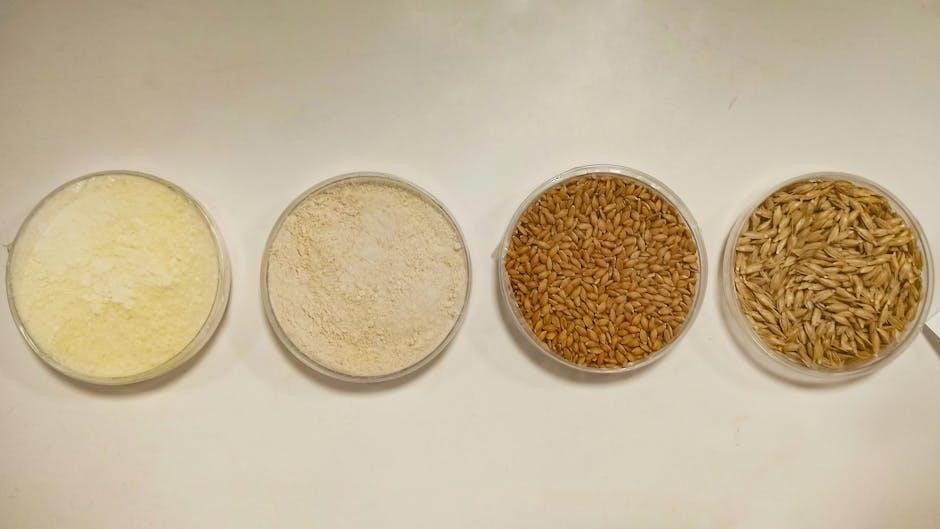Macronutrients—carbohydrates, proteins, and fats—are essential nutrients required in large amounts to provide energy and support bodily functions․ Understanding their roles and balance is crucial for optimal health and performance․
1․1 Definition of Carbohydrates, Proteins, and Fats
Carbohydrates are compounds of carbon, hydrogen, and oxygen, serving as the body’s primary energy source․ Proteins are made of amino acids, essential for tissue repair and growth․ Fats, also carbon, hydrogen, and oxygen, are calorie-dense and vital for energy storage and hormone production․ These macronutrients differ in structure and function but work together to sustain life and bodily functions․
1․2 Importance of Macronutrients in the Diet
Macronutrients are vital for energy production, growth, and maintaining bodily functions․ Carbohydrates fuel physical activity, proteins repair tissues, and fats support hormone production․ A balanced intake ensures optimal health, prevents deficiencies, and supports weight management․ They work synergistically to maintain metabolic processes, making them indispensable in a healthy diet․

Carbohydrates
Carbohydrates are the body’s primary energy source, fueling physical activity and brain function․ They come in simple and complex forms, playing a crucial role in overall health and vitality․
2․1 Types of Carbohydrates: Simple and Complex
Simple carbohydrates, like sugars, are quickly absorbed, providing rapid energy․ Complex carbohydrates, such as starches and fibers, digest slowly, offering sustained energy․ Both types are essential for energy production, with complex carbs promoting better blood sugar control and overall health benefits․ Understanding their differences helps in making informed dietary choices for optimal nutrition and energy balance;
2․2 Food Sources of Carbohydrates
Whole grains, fruits, vegetables, and legumes are rich sources of complex carbohydrates․ Refined foods like white bread, pasta, and sugary snacks provide simple carbs․ Dairy products, such as milk and yogurt, contain carbohydrates in the form of lactose․ Incorporating a variety of these foods ensures a balanced intake of carbs, supporting energy needs and overall health effectively․
2․3 Role of Carbohydrates in the Body
Carbohydrates are the body’s primary energy source, fueling the brain, muscles, and other vital organs․ They are converted into glucose, which powers bodily functions and physical activity․ Fiber, a type of complex carb, aids digestion and promotes gut health․ Adequate carb intake supports mental clarity, physical performance, and overall metabolic balance, making them indispensable for maintaining energy and health effectively․

Proteins
Proteins are essential for muscle growth and repair, comprising amino acids․ Found in lean meats, fish, eggs, and plant-based sources, they support weight management and overall health․
3․1 Essential and Non-Essential Amino Acids
Amino acids are the building blocks of proteins, divided into essential and non-essential categories․ Essential amino acids (EAAs) must be obtained from the diet, while non-essential amino acids can be synthesized by the body․ There are nine EAAs crucial for muscle growth, tissue repair, and metabolic functions․ Food sources like lean meats, fish, eggs, and plant-based options provide these amino acids, ensuring proper protein synthesis and overall health․
3․2 High-Protein Food Sources
High-protein foods are vital for muscle growth and repair․ Lean meats like chicken and turkey, fish, eggs, and dairy products are excellent sources․ Plant-based options include legumes, beans, tofu, and edamame․ Nuts and seeds also provide significant protein․ A balanced diet incorporating these sources ensures adequate protein intake, supporting overall health and muscle maintenance, as outlined in the carbohydrates, proteins, and fats chart PDF․
3․3 Importance of Protein for Muscle Growth and Repair
Protein is essential for muscle growth and repair, as it provides the amino acids needed to build and maintain muscle tissue․ Without sufficient protein, muscle loss and weakness can occur․ Adequate intake supports muscle recovery after exercise and helps maintain muscle mass, which is vital for overall health and physical performance, as detailed in the carbohydrates, proteins, and fats chart PDF․

Fats
Fats are calorie-dense macronutrients providing 9 calories per gram, composed of carbon, hydrogen, and oxygen․ They are categorized into saturated, unsaturated, and trans fats, with healthy sources including nuts, seeds, avocados, and olive oil, as detailed in the carbohydrates, proteins, and fats chart PDF․
4․1 Types of Fats: Saturated, Unsaturated, and Trans Fats
Fats are categorized into three main types: saturated, unsaturated, and trans fats․ Saturated fats, found in dairy and red meat, are linked to higher cholesterol levels․ Unsaturated fats, including monounsaturated and polyunsaturated, are healthier and found in nuts, seeds, and fatty fish․ Trans fats, often in processed foods, are harmful and increase heart disease risk․ The carbohydrates, proteins, and fats chart PDF provides a detailed comparison of their sources and health impacts․
4․2 Healthy Sources of Fats
Healthy fats are derived from whole, unprocessed foods․ Unsaturated fats are found in nuts, seeds, avocados, and olive oil․ Fatty fish like salmon and mackerel are rich in omega-3s․ The carbohydrates, proteins, and fats chart PDF highlights these sources, emphasizing whole food choices over refined options to maximize nutritional benefits and support overall health․
4․3 Role of Fats in Energy and Hormone Production
Fats are vital for energy storage and hormone production․ They provide 9 calories per gram, making them the most energy-dense macronutrient․ Essential fatty acids support hormone synthesis, including those regulating growth, reproduction, and metabolism․ The carbohydrates, proteins, and fats chart PDF emphasizes the importance of healthy fat sources for maintaining energy levels and hormonal balance, ensuring proper bodily functions and overall health․
Macronutrient Balance
A balanced diet typically consists of 40% carbohydrates, 30% proteins, and 30% fats․ This ratio provides sustained energy and supports overall health, though adjustments may be needed for individual needs․
5․1 Recommended Daily Intake of Carbs, Proteins, and Fats
The recommended daily intake of macronutrients varies based on individual needs․ A balanced diet typically includes 40% of calories from carbohydrates, 30% from proteins, and 30% from fats․ For most adults, this translates to 5-6g of carbs per kilogram of body weight, 1․6-2․2g of protein per kilogram, and 0․5-1g of fats per kilogram․ This balance ensures adequate energy and supports bodily functions, though specific requirements may vary based on activity levels and health goals․
5․2 How to Create a Balanced Diet
To create a balanced diet, start by using a macronutrient chart to track carbs, proteins, and fats․ Incorporate a variety of whole foods, such as lean proteins, healthy fats, and complex carbs․ Aim for portion sizes that align with your daily goals․ Plan meals in advance and adjust based on your activity level and health objectives․ Consulting a dietitian or using meal planning tools can also help ensure a well-rounded intake;

Carbohydrates, Proteins, and Fats Chart
A carbohydrates, proteins, and fats chart provides a clear breakdown of macronutrient content in foods, helping users track and balance their daily intake effectively․ Download the free PDF guide for easy reference and meal planning․
6․1 Overview of the Chart
The Carbohydrates, Proteins, and Fats Chart offers a comprehensive overview of macronutrient content in various foods․ It categorizes items by their protein, fat, and carb levels, providing clear nutritional insights․ This chart is designed to simplify meal planning, helping users make informed dietary choices․ Whether for weight management or general health, it serves as an essential tool for balancing macronutrient intake efficiently․
6․2 How to Use the Chart for Meal Planning
The chart simplifies meal planning by categorizing foods based on their macronutrient content․ Users can identify ideal carbohydrate, protein, and fat ratios for their dietary needs․ Plan meals by selecting foods that align with your daily macro goals․ Adjust portion sizes to meet calorie requirements․ Track intake to ensure a balanced diet․ Use the chart to create a weekly meal plan or as a quick reference for making healthy choices․ Download the PDF for easy access and share with others for collaborative planning․

Health Implications of Macronutrient Imbalance
An imbalance in carbohydrates, proteins, or fats can lead to health issues like weight gain, muscle loss, or increased disease risk․ Proper balance is key for overall well-being and optimal bodily function․
7․1 Effects of Excessive Carbohydrate Consumption
Excessive carbohydrate intake can lead to insulin spikes, weight gain, and energy crashes․ High-carb diets, especially those rich in sugars, may contribute to metabolic issues like diabetes and fatty liver disease․ Overconsumption of refined carbs can also displace protein and fat intake, causing muscle loss and hormonal imbalances․ Balancing carbs with protein and fats is essential to avoid these negative health effects and maintain proper metabolic function․
7․2 Risks of Low Protein Intake
Low protein intake can lead to muscle loss, weakness, and impaired immune function․ It may also cause anemia, fatigue, and digestive issues due to insufficient enzymes․ Prolonged deficiency can result in organ damage and increased disease risk․ Ensuring adequate protein from sources like lean meats, fish, dairy, nuts, and seeds is crucial for maintaining muscle mass and overall health, especially for active individuals and those with higher energy needs․
7․3 Dangers of High Fat Diets
High fat diets, particularly those rich in saturated and trans fats, can increase the risk of obesity, heart disease, and diabetes․ Excessive fat intake can lead to weight gain, elevated cholesterol levels, and inflammation․ Diets dominated by processed and fried foods often contribute to chronic health conditions․ Balancing fat intake with lean sources like nuts, seeds, and olive oil is essential to avoid these risks and maintain overall well-being․

Macronutrients and Weight Management
Macronutrient balance is key to weight management․ Carbs provide quick energy, proteins support muscle retention, and fats contribute to satiety․ Balancing these helps regulate metabolism and appetite effectively․
8․1 Role of Carbohydrates in Weight Gain
Carbohydrates play a significant role in weight gain as they are the body’s primary energy source․ Consuming more carbs than needed can lead to excess calories being stored as fat․ Simple carbs, like sugars, cause rapid insulin spikes, promoting fat storage․ Complex carbs, such as whole grains, provide sustained energy but can still contribute to weight gain if overeaten․ Balancing carb intake with physical activity and other macronutrients is essential for maintaining a healthy weight․
8․2 Protein’s Impact on Weight Loss
Protein plays a key role in weight loss by increasing satiety, boosting metabolism, and preserving muscle mass․ High-protein diets help reduce appetite and calorie intake, while maintaining lean tissue during calorie deficits․ This ensures that weight loss comes from fat, not muscle․ Incorporating protein-rich foods into meals can support fat burning and overall weight management, making it a vital component of a weight-loss diet․
8․3 Fats and Their Influence on Body Weight
Fats, being calorie-dense, significantly impact body weight․ Healthy fats like avocados and nuts support satiety, while excessive intake of saturated and trans fats can lead to weight gain․ Balancing fat intake is crucial, as they provide 9 calories per gram, influencing energy storage and metabolism․ Moderate consumption of healthy fats aids weight management and overall health, while overconsumption can contribute to obesity and related health issues․

Macronutrient Needs for Different Diets
Different diets require tailored macronutrient balances․ High-protein diets focus on muscle building, low-carb diets emphasize fat utilization, and plant-based diets prioritize balanced intake from whole foods․
9․1 High-Protein Diets for Muscle Building
High-protein diets are ideal for muscle building, with protein intake often reaching 40% of total calories․ This supports muscle synthesis and repair․ Carbohydrates and fats are balanced to provide energy, while protein sources like lean meats, fish, and plant-based options are prioritized․ A structured meal plan and tracking with a carbohydrates, proteins, and fats chart PDF can help maintain this balance effectively for optimal muscle growth․
9․2 Low-Carb Diets for Weight Loss
Low-carb diets focus on reducing carbohydrate intake to promote fat burning and weight loss․ They emphasize protein and healthy fats while minimizing sugars and starches․ This approach helps stabilize blood sugar and reduce hunger․ A carbohydrates, proteins, and fats chart PDF can guide meal planning, ensuring balanced nutrition while adhering to low-carb principles for effective weight management․
9․3 Plant-Based Diets and Macronutrient Balance
Plant-based diets emphasize whole foods like fruits, vegetables, legumes, and grains, naturally rich in carbohydrates and fiber․ They often require careful planning to ensure adequate protein and healthy fats․ A carbohydrates, proteins, and fats chart PDF can help track intake, balancing macronutrients while avoiding refined sources․ This approach supports overall health and sustainability, making it easier to maintain a balanced diet without animal products․

Practical Tips for Tracking Macronutrients
Use a food diary or apps to monitor daily intake of carbs, proteins, and fats․ Download a carbohydrates, proteins, and fats chart PDF for easy reference and accurate tracking․
10․1 Using a Food Diary
A food diary is a practical tool for tracking your daily intake of carbohydrates, proteins, and fats․ By documenting each meal, you can monitor portion sizes and ensure macronutrient balance․ For example, note lean protein sources like chicken or fish, healthy fats such as avocados, and complex carbs like whole grains․ Referencing a carbohydrates, proteins, and fats chart PDF can help verify serving sizes and align your intake with dietary goals․
10․2 Macronutrient Tracking Apps
Macronutrient tracking apps like MyFitnessPal or MyNetDiary simplify monitoring of your daily carbohydrates, proteins, and fats․ These apps allow you to scan barcodes, search databases, and log meals in real-time․ They provide detailed breakdowns of your macronutrient intake, helping you stay on track with your dietary goals․ Many apps also offer integration with wearable devices and customizable meal plans, making it easier to balance your intake using a carbohydrates, proteins, and fats chart PDF for reference․
Balancing carbohydrates, proteins, and fats is vital for energy and health․ Using tools like a macronutrient chart PDF can help you achieve this balance effectively․
11․1 Summary of Key Points
Macronutrients—carbohydrates, proteins, and fats—are essential for energy and bodily functions․ Carbohydrates are the primary energy source, while proteins support muscle growth and repair․ Fats aid in energy storage and hormone production․ Balancing these nutrients is crucial for overall health and performance․ A macronutrient chart PDF is a valuable tool for tracking and maintaining this balance, ensuring optimal intake for individual needs and goals․
11․2 Final Thoughts on Macronutrient Balance
Macronutrient balance is the foundation of a healthy diet, ensuring energy, growth, and overall well-being․ By understanding the roles of carbohydrates, proteins, and fats, individuals can tailor their intake to meet specific goals, whether for weight management, muscle building, or general health․ A carbohydrates, proteins, and fats chart PDF serves as a practical guide to simplify tracking and achieving this balance effectively․

Additional Resources
Download our FREE Carbohydrates, Proteins, and Fats Chart PDF for a quick guide to simplify your diet and track macros effectively․ Easy to understand and use today!
12․1 Where to Find the Carbohydrates, Proteins, and Fats Chart PDF
Access the Carbohydrates, Proteins, and Fats Chart PDF for free by visiting our website․ This downloadable guide simplifies macronutrient tracking with detailed food lists, portion sizes, and nutritional breakdowns․ Perfect for meal planning, it’s easy to print and use daily․ Visit the site today and start managing your macros effectively․ For support, contact us at support@youronelife․co․uk․
12․2 Recommended Reading for Further Learning
For deeper insights, explore “The Complete Guide to Macronutrients” by AE Shestopalov and “Nutrition Science” by PC Ojileh․ These resources offer comprehensive breakdowns of carbs, proteins, and fats, including practical meal plans and scientific research․ Additionally, “Macronutrient Balance for Health” provides expert advice on optimizing your diet for energy and wellness․ These books are available on major online platforms and in local bookstores․